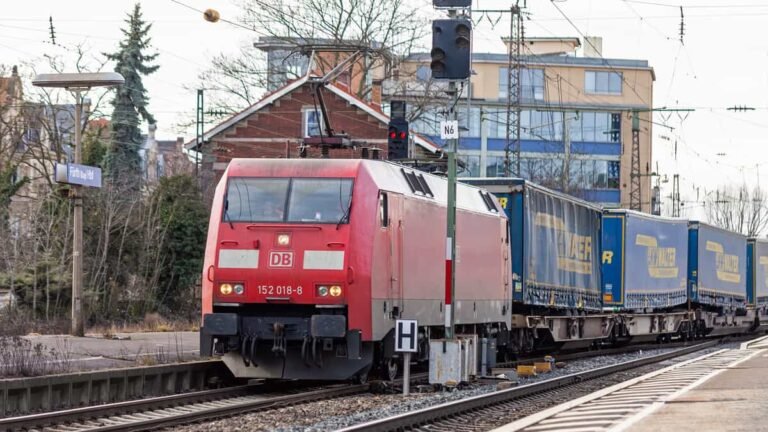Over the past two months, major container lines and allied carriers have canceled many of their flights from Asia to Europe, due to weak demand in the peak season. Since July 2019, seasonal rates have been consistently lower year-on-year with container rates falling on lanes from China to Northern Europe; There was a 21% decrease this month compared to October 2018.
Container lines are offloading their heads because it helps them achieve a slight stabilization in lower spot prices for containers. However, this will come at the expense of North America, as every ship withdrawn from the European market will mean the loss of a return trip from North America.
To a neutral observer, shrinking maritime capacity between Asia and Europe could be a marketing opportunity for the trans-European multimodal rail system that now boasts connectivity to China’s toiling east coast, made possible by Beijing’s One Belt, One Road initiative. But unlike the way the United States makes use of an extensive rail network to transport goods, Europe does no such thing, and its freight rail system lags behind the United States by several decades.
The reason for this gap in rail freight growth is because there is a fundamental difference in perspective. Europe has never measured the effectiveness of a well-designed railway system by the volume of goods it transports, but by the number of passengers it can carry.
“With the privatization of railroads in the United States, we have consistently moved toward heavier axle loads over the past four decades. Our standard rail cars can handle 286,000 pounds. Each car has four axles, so each axle can handle about 71,500 pounds, That’s 32.5 metric tons. “In Europe, the typical axle load is only about 20 to 23 metric tons,” said Jim Blaze, a retired U.S. railroad employee.
Compounding the problems is the length allowed for each freight train in Europe. For operational purposes, the total permissible length of a freight train in Europe is 700 meters (~2,300 ft) and the maximum length of a train including its locomotive and extension can be up to 750 meters (~2,460 ft).
This is small compared to American freight trains, which average about 2,000 meters (6,600 feet) in length. Freight train lengths exceeding 6,000 meters (~19,700 ft) can also be seen frequently in the United States, made possible by adding a few locomotive units to the cars, either at the end or in between for additional power.
“Europe’s maximum train length of 750 meters is necessary for a system that relies on transporting passengers rather than freight. Trains need to be able to brake quickly when they are transporting passengers, and that becomes difficult as trains get longer,” Blaise said.
Another issue is the vertical height of the cars. In the United States, vertical height limits have been rewritten several times, with newly built cars now being 23 feet from the rail. In Europe, vertical car heights have remained at 15 to 16 feet, about 30% lower than the height of rail cars in the United States.
“At 15 to 16 feet, European railways can’t handle double stacks,” Blaise said. “If you go to a freight car platform with a double design, you get an immediate 35-45% reduction per container mile in rail freight costs.” Railways. Europe has been stuck with the same size of freight trains as it was after World War II. Meanwhile, maritime competitors have grown in size over the years.
European railways had no incentive to take the risk of re-engineering and spending billions of euros to increase permits and rework tunnel heights for double-track cars, because the European railway business model was about transporting passengers, not freight – the opposite of what North America does. I dealt with the railway system.
However, Blaise pointed out how commercial necessity helped convert the Scandinavian Railway line that runs within the Norwegian and Swedish borders to carry about 30 metric tons on each axle load, as opposed to the normal 20 to 23 metric tons carried in other parts of the country. Europe.
This line extends from the port of Narvik, a Norwegian town located north of the Arctic Circle, to the Swedish city of Kiruna, where iron ore is extracted. It so happened that in 1998, the Swedish mine owner announced that transporting iron ore from Kiruna to Narvik was too expensive, and that he would be forced to close the mine if the cost per ton-mile was not reduced. The fire.
This led to massive renovations to the railway line, with Sweden strengthening the tracks, fortifying the anchors that hold the track, and increasing the lengths of track on curves and at crossings. These improvements helped ensure that rail cars could carry heavier loads.
“Increased axle loads meant 20% more loads per car. Even though they had to increase their track maintenance budget by about 20%, the railroad had lower crew costs, lower engine costs, and lower equipment costs because it was getting better use of the equipment.” This has resulted in a net increase of 28-30% in savings on iron ore movement.
Looking at this example, it can be concluded that what happened in Scandinavia could be replicated by German Deutsche Bahn or Swiss railways. Europe’s failure to pay attention to strengthening its freight rail system ultimately boils down to a lack of incentives. The countries in question operate their share of Europe’s railway network and have not allowed the privatization of the railway sector as is the case in North America.
In essence, it is time for Europe to address the elephant in the room. For the EU, the equation is simple – increase capital expenditure on the aging railway system and look to gain volume from the maritime market that seems particularly vulnerable today.





